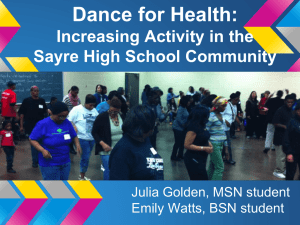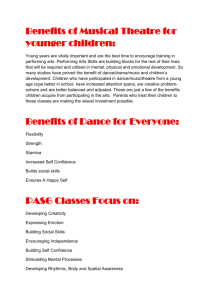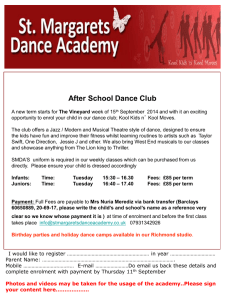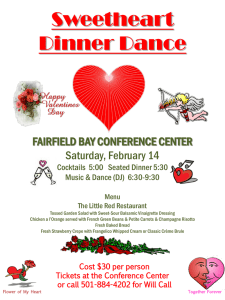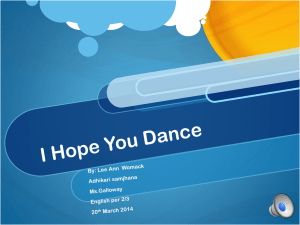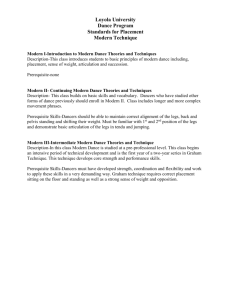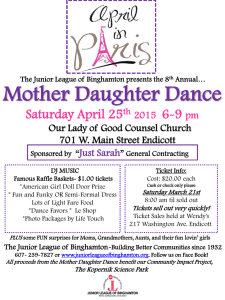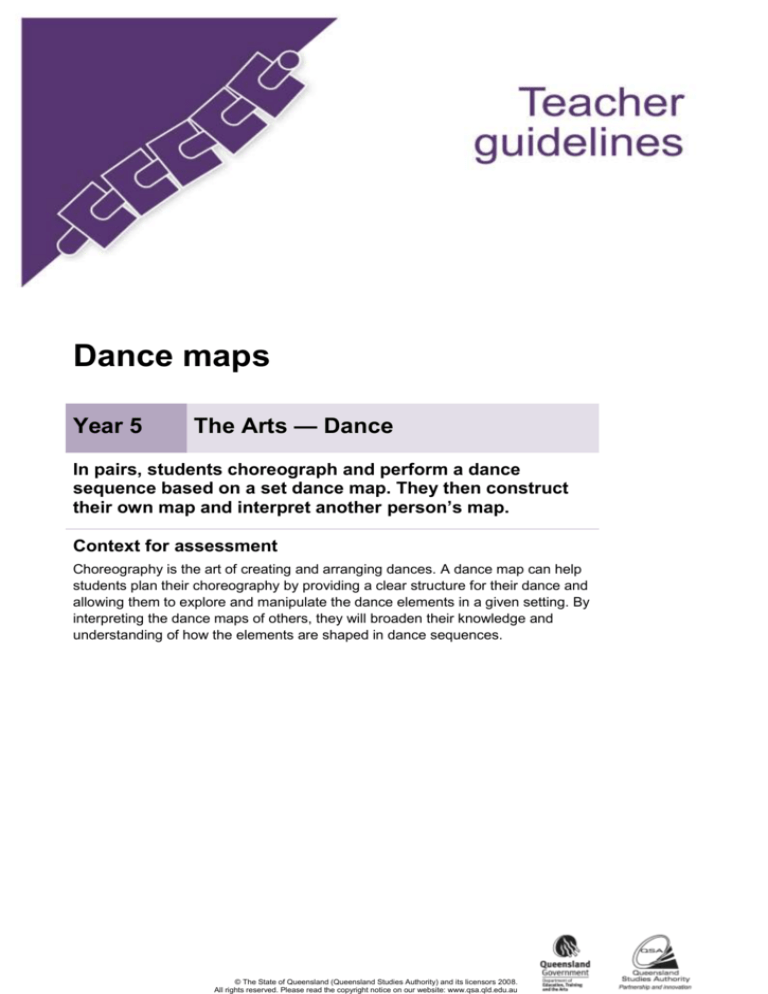
Dance maps
Year 5
The Arts — Dance
In pairs, students choreograph and perform a dance
sequence based on a set dance map. They then construct
their own map and interpret another person’s map.
Context for assessment
Choreography is the art of creating and arranging dances. A dance map can help
students plan their choreography by providing a clear structure for their dance and
allowing them to explore and manipulate the dance elements in a given setting. By
interpreting the dance maps of others, they will broaden their knowledge and
understanding of how the elements are shaped in dance sequences.
© The State of Queensland (Queensland Studies Authority) and its licensors 2008.
All rights reserved. Please read the copyright notice on our website: www.qsa.qld.edu.au
Teacher guidelines
This assessment gathers evidence of learning for the following Essential Learnings:
The Arts
Essential Learnings by the end of Year 5
Ways of working
Knowledge and understanding
Students are able to:
Dance
select and develop ideas for arts
works, considering different
audiences and different purposes,
using arts elements and languages
Dance involves using the human body to express
ideas, considering different audiences and
different purposes, by selecting dance elements in
short movement sequences.
create and shape arts works by
organising arts elements to
express personal and community
values, beliefs and observations
rehearse and rework arts works,
using interpretive and technical
skills
Gross and fine motor movements, including
locomotor and non-locomotor, are used to create
actions for short movement sequences.
Group formations are used to organise dancers in
short movement sequences.
Simple rhythmic patterns are used for timing of
movements in short movement sequences.
present arts works to informal and
formal audiences, using arts
techniques, skills and processes
Swinging and collapsing movement qualities are
used to alter energy in short movement
sequences.
identify and apply safe practices
respond to arts works by identifying
and interpreting the influences of
social, cultural and historical
contexts, using arts elements and
languages.
Structuring devices, including contrast and canon
forms, are used to organise short movement
sequences.
Assessable elements
Knowledge and understanding
Creating
Presenting
Responding
Source: Queensland Studies Authority 2007, The Arts Essential Learnings by the end of Year 5, QSA, Brisbane.
2
Year 5 The Arts — Dance: Dance maps
Listed here are suggested learning experiences for students before they attempt this
assessment.
Explore dance elements (action, space, time, energy and form) in various choreographic
exercises.
Refine performance skills (coordination, control, clarity, projection, focus, movement qualities
and tempo) through rehearsal and feedback.
Interpret structuring devices such as dance maps to gain an understanding of dance form.
Work in pairs on dance movements and ideas.
Respond to the use of dance elements to express ideas in their own and others’ work.
Discuss dance, in both oral and written responses, using suitable words from a dance word
bank.
View videos of dance to see how space is used (e.g. an episode of the TV program So you
think you can dance, any of the animated Disney films).
Teacher resources
Appendix A
Dance classroom management
This resource gives guidelines for managing a dance classroom, covering
organisation, preparation for movement, and safety considerations.
Snook, B 2004, Dance — Count Me In, McGraw Hill, Sydney.
Wauchop, D 2004, Dancing in Space (text and CD-ROM), Piper Press, Sydney.
3
Teacher guidelines
Preparing
Consider these points before implementing the assessment:
Prepare a safe working environment — a large uncluttered area where students can move
safely without bumping into each other, the walls or furnishings. Read through “Organising a
dance classroom” in Appendix A: Dance classroom management, for guidelines.
A warm-up and cool-down is an essential part of any movement lesson. Appendix A: Dance
classroom management, has suggested activities you may wish to use.
Implementation
When implementing Section 1, teachers may provide examples of sections of choreography
created from the map to guide students through the creative process.
Example of a section of the dance map
In this first section of the map, the dancer starts by standing in a fully upright position in the back
corner (stage left) with arms extended to the sides, facing the back wall. They turn to face the front
corner (stage right) and begin walking along an imaginary wavy line towards the centre of the
stage while circling their arms above their head. After the second circle of the arms, the upper body
curves forward and they slowly sink to the floor and slide on their stomach to the centre of the
room, then shape their body into a twisted pose on the floor.
4
Year 5 The Arts — Dance: Dance maps
Sample implementation plan
This table shows one way that this assessment can be implemented. It is a guide only — you may
choose to use all, part or none of the table. You may customise the table to suit your students and
their school environment.
Suggested time
Student activity
Teacher role
Section 1. Choreograph a set dance map
Two hours
Work in pairs to develop a movement
sequence that represents the cue words
and visual information on the set dance
map.
Guide students through the map.
Provide feedback as students develop
their choreography.
Monitor each pair to ensure they are
sharing the choreographic process and
highlighting the sections of the map
they create.
Note: It would be best for each student
to complete continuous sections of the
map rather than choosing random
words at different points on the map.
Section 2. Perform a set dance map
One hour
Rehearse to improve performance skills.
Perform sequences for the class.
After watching the sequences of other
pairs, participate in an informal class
discussion.
Help students to complete the
performance feedback in the Student
booklet, focusing on skills of
coordination, control, clarity, projection,
focus, movement qualities and tempo.
Provide guiding questions for informal
discussion of sequences.
Use Appendix C, Dance word bank, to
supply appropriate cue words.
Section 3. Create and critique dance maps
30 minutes
Follow the instructions on the Planning
sheet to create individual dance maps.
Guide and assist students.
One hour
Using the dance map of another member
of the class, physically interpret the
sequence by walking through and trying
the options suggested.
Guide and assist students.
Organise uncluttered space for walking
through maps.
Complete the Critique a dance map sheet
to see whether it covers all the
requirements (as outlined in Section 3 of
the Student booklet).
Resources for the assessment
Appendix B
Choreography, performance and audience etiquette
Appendix C
Dance word bank
5
Teacher guidelines
During the learning process, you and your students should have developed a shared
understanding of the curriculum expectations identified as part of the planning process.
After students have completed the assessment, identify, gather and interpret the information
provided in student responses. Use only the evidence in student responses to make your judgment
about the quality of the student learning. Refer to the following documents to assist you in making
standards-referenced judgments:
Guide to making judgments
Indicative A response
Sample responses (where available).
Making judgments about this assessment
Teachers need to monitor carefully the individual contribution to the pair sequence.
Video documentation will help support the teacher judgments as it can be difficult to assess
creating and performing when viewing live performance.
For further information, refer to Using a Guide to making judgments in the Resources
section of the Assessment Bank website.
Evaluate the information gathered from the assessment to guide teaching and learning strategies.
Involve students in the feedback process. Give students opportunities to ask follow-up questions
and share their learning observations or experiences.
Focus feedback on the student’s personal progress. Emphasise continuous progress relative to
their previous achievement and to the learning expectations — avoid comparing a student with
their classmates.
6
Year 5 The Arts — Dance: Dance maps
Giving feedback about this assessment
Within this assessment, feedback questions are included to allow students to gather
information to improve their performance skills.
Teachers may similarly use the Planning sheet on page 5 of student booklet to provide
information on the creative process.
For further information refer to Using feedback in the Resources section of the
Assessment Bank website.
7
Appendix A
Dance classroom management
Organising a dance classroom
For a dance lesson to be a positive experience for all, consideration needs to be given to the
space where the lesson is to take place, as well as the way the lesson is conducted.
Clear the space of any desks, chairs and other moveable objects, so that all students are
able to move freely, on their own or in small groups in the space, without bumping into
others or objects.
Ideally, a bare wooden floor, not lying directly in contact with concrete, is the most suitable
flooring for dance. If a carpet-covered, concrete floor is all that is available, it is advisable
that no jumping action takes place.
When using media equipment, it is important that it is on a table or shelf out of the way of
the movement that is taking place. Be aware of the volume of the accompanying recorded
or live music. If the music is too loud students will not be able to hear teacher instructions,
there will be risk of voice strain, and nearby classes will be interrupted.
The duration of a dance lesson should run approximately 35 to 45 minutes. This time does
not include set-up and pack-up time. The actual number of activities in a lesson will depend
on how much development or expansion of the activities takes place.
It is beneficial to revisit movement sequences or activities from previous lessons, so that
students build their movement vocabulary.
If students are required to remove their shoes, establish a place for the shoes that is out of
the way of the movement.
Encourage the students to wear clothing that is not restrictive, is modest, and offers
protection from the sun if dance is to take place outdoors.
Preparation for movement — warm-up and cool-down
Prior to beginning any movement lesson, a warm-up is essential. An ideal warm-up should
involve visual and verbal instructions from the teacher. During warm-up exercises it is important
that each student is able to follow teacher instructions.
Warm-up could include:
simple stretching and bending movements that involve the entire body
small gentle movements that isolate and prepare joints such as ankles and wrists
locomotor and non-locomotor aerobic exercises that raise heart rate and increase blood
circulation.
The warm-up should be connected to the content or stimulus of the lesson to develop the
understanding that warm-up is preparation for movement and not an isolated experience. Using
music that reflects the stimulus of the lesson, or incorporating simplified versions of movements
the students may use in the lesson, is an easy way to do this.
During the cool-down, students should stretch slowly using movements that reflect the content
of the lesson in addition to familiar movements from the warm-up. Encourage students to reflect
on what has occurred during the lesson.
Safety considerations
Students should:
respect other students; allow them enough room to move without bumping into each other
remove shoes so that other students are not injured while moving on the floor
remove socks if the floor surface is slippery
not make physical contact with other students unless specifically requested by the teacher
when performing partner or group activities
be aware of the objects around the room that may need to be avoided — for example, the
edges of desks, chairs, windows or doorways.
Adapted from “Dance classroom management”, The Office of the Queensland School Curriculum Council 2002.
Appendix B
Choreography, performance and audience etiquette
Teachers and students may use this information to create a Y-chart highlighting appropriate
information for each of these etiquette contexts.
Looks like …
Sounds like …
Feels like …
Choreography etiquette
Students should:
work cooperatively within the group
rehearse as if it were a real performance
contribute to group decisions
be helpful to other group members.
Performance etiquette
Students should:
concentrate, focus and commit to the performance
be ready for entrances and beginnings
be ready for exits and endings.
Audience etiquette
The success of a performance depends in part on the audience. By creating a supportive and
focused atmosphere, we help to ensure that everyone enjoys the experience.
Students should:
watch the performance attentively, remaining quiet and respectful
not laugh at or distract the performers
applaud at the end of the performance to show respect for the performers
give positive, specific and useful feedback.
Appendix C
Dance word bank
Words for performance
strong
energetic
powerful
gentle
smooth
fast
slow
pause
interesting
exciting
controlled
concentrating
linked
lively
appealing
skilful
graceful
forwards
backwards
Words for levels
low-level
medium-level
high-level
Words for directions
sideways
diagonal
in a circle
Words for shapes
stretched
zigzag
squiggly
start
end
angular
round
sharp
long
curved
open
small
big
twisted
bent
symmetrical
asymmetrical
narrow
wide
long
Words for movement qualities
percussive
falling
swinging

